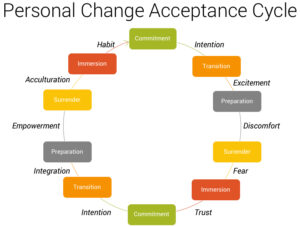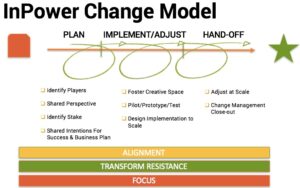Change Leadership
Change leadership and change management have become perpetual topics in business literature. Yet the outcomes from all the resultant models and protocols created have been dismal. At InPower Coaching, we’ve found leaders’ interpersonal and cultural effectiveness to be the key to leading and managing change. Read below for our top learnings and advice on how you can lead change in your organization.
How Many Change Projects Succeed?
%
1993
How Many Change Projects Succeed?
%
2016
Are we getting better at organizational change?
Change statistics have been tracked over the last 30 years. In that time hundreds of books and processes and studies have been generated trying to figure out how to make change processes work better.
Guess how much we’ve improved in the last thirty years?
4%!
Source: CEB/Gartner
New Learnings: Organizational Change
Middle Management Makes or Breaks Change Leadership
seMost change efforts are thought up by executives, and sometimes consultants, and are handed down to middle management to implement. This is why so many executives are frustrated with how slowly change happens, if it happens at all. They are handing it off to perfectly capable middle managers, who have rarely been engaged in the process and so feel little ownership in the change. People who feel no ownership will always struggle to own the change.
Middle management is where change goes to die in our company. – Anonymous HR Leader
There are plenty of change management frameworks out there, and what the stats show us is that only about 34% of the organizations that use them to implement change in middle management have the soft skills to take full advantage of the frameworks and realize success. Many more companies’ middle management layers are lacking the soft skills to manage resistance as the strategic asset that it is.
We think of mid-level managers as managing incremental change — but many are change leaders in the making. When they align their personal goals and strengths with the organization’s goals, they become extraordinary leaders. – Behnam Tabrizi, Harvard Business Review
Have the Answer to "What's Next"?
Change doesn’t work this way.
Here are three keys to making sure a change initiative can take root and grow:
- Engage all stakeholders in deciding how to implement the change
- Engage middle managers in deciding how to launch the change
- Plan to iterate, test and refine the change
Every announcement about change needs to anticipate and answer the inevitable questions that will crop up. By engaging people in the process, you’ll always have the answer to their “what’s next?” questions, because they will have helped you develop the answers.
Do People Really “Hate Change”? (No!)
Despite the fact that companies are initiating more change projects than ever before, executive leaders are becoming more frustrated with the slow pace of change, and yet they realize that their organizations must become proficient at change in order to survive.
What’s missing for such a universal need to go so regularly unmet?
It’s our experience helping hundreds of leaders learn to spearhead and shepherd change that success lies along parallel paths to help both individuals and groups adjust to change.
When change competence becomes a cultural habit, change initiatives can succeed on a regular basis.
InPowered Approaches to Change Management
In addition to process-oriented models for change management we must also look at the complexities of personal change. In our view, people traverse a counter-intuitive path to personal change which takes them through 5 core stages, and then back out through those same stages, but with a different emotional orientation.
“Nudge” theory, popularized by Nobel Prizewinning economist Robert Thayer, PhD, in his book Nudge: Improving Decisions About Health, Wealth & Happiness, provided evidence for how small changes can produce large results, when introduced thoughtfully and consistently. The same dynamic exists in cultural change efforts. By building on small, but deeply embedded improvements in core, Emotional Intelligence-infused cultural changes, an organization can quickly see improvements that provide employees and leaders opportunities to incorporate change resilience and change receptivity into their day-to-day practices.
Think it can’t be done where you work? It can! Anything is possible where InPowered change leaders take on the challenge.
Contact us to learn more about InPower Coaching’s change management and change leadership programs for mid-level and executive leaders. All our programs can be implemented as stand alone change management frameworks, or implemented alongside existing programs such as Lean Six Sigma, Kotter’s 8 Steps or ATD’s Change Management framework.
At InPower Coaching, we know that change is iterative, even as you advance through the standard phases of Planning, Implementation and Hand-off. Using three core principles of change (Alignment, Transforming Resistance and Focus), we guide the four primary players (Sponsor, Change Leader, Stakeholders and Consultants) through the process.
Change is Speeding Up
- companies expecting 5+ major changes in the next 5 years 73%
Free Whitepaper
Here’s what’s included in this 30 page PDF White Paper on Change Leadership and Management:
- Recent research findings on change success and failure rates
- 6 common factors in why change efforts fail
- Distinctions between the “art” and “science” of change
- Distinctions between a change manager and a change master
- A 9 step model for organizational change management
- A 10 step model for personal change
- Personalized change leadership coaching advice to 4 key personas: Sponsor, Change Team, Key Stakeholders & Consultant


